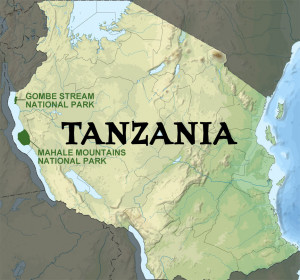Family Reunion: The Chimpanzees of Mahale
Chimpanzee in Gombe Stream National Park
Photo: Thomson Safaris guest, Stewart Halperin
It’s always good to remember where you came from, and for human beings, family ties connect us most closely to one particular species: chimpanzees.
We share upwards of 94% of our genome with chimps (some estimates claim our genes are as much as 99% identical to chimps’), and dozens of well-observed chimp behaviors—including tool use, language abilities, and higher-level emotions such as altruism and romantic love—make it easy to see our shared ancestry. We’re so closely tied we even share diseases; a recent study showed that wild chimps with viral diseases likely contracted them from human visitors.

Jane Goodall’s groundbreaking research on the lives of wild chimpanzees occurred entirely at Gombe Stream, a tiny national park on the borders of Lake Tanganyika. Our favorite spot to observe chimps, however, is in the nearby Mahale Mountains National Park, home to the largest group of free-roaming chimpanzees in the world.
Even for Tanzania—a country notoriously lacking in the transportation infrastructure westerners take for granted—Mahale is extremely remote. Visitors have to arrive via plane, then cross the Lake on a boat, before they reach the park proper (trains from Dar es Salaam do travel here…but they take around three full days to reach the remote area).
But that’s only the beginning of the adventure; Mahale has no permanent roads, so all safaris through the park take place on foot (with the help of highly-trained guides, of course).
Visitors interested in tracking the chimps are in for a treat…and a physical challenge. The hilly terrain around the park requires serious physical fitness. But when your guide manages to track down some of the hundreds of chimps that call the park home, that effort will be amply rewarded.
Park officials are very careful not to damage the chimps’ fragile environments, insisting that visitors stay a certain distance away (to prevent cross-species infection); that they refrain from eating, drinking, or answering “calls of nature” too near the chimps’ environments; and even that they never let go of anything they’re carrying on the trail—the chimps are so agile and curious, they might snatch it otherwise!
Medical masks are necessary when trekking in Mahale to protect the chimps from catching our diseases, which they have no defenses for.
Photo: Thomson Safaris guest, Helen Parrish
The chimps living in the forests of the Mahale mountains are protected from too much human intrusion, but they have been extensively studied, since as far back as 1965. It was here that scientists first observed chimps employing tools—sticks used to “fish” for termites—and here that they’ve observed wild chimps using local flora medicinally when they’re sick or injured.
But that’s not all there is to see at Mahale. Dozens of species can be found on walking safaris through the park, including lions (Mahale is one of the only parks where a wild chimp population lives with a wild lion population).
So if you have a chance to get to the western reaches of Tanzania, take the extra effort to check in with your distant cousins. You might be surprised by just how much they can teach you about yourself!


